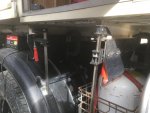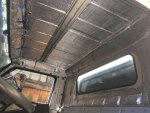yabanja
Explorer
Great idea Allan, especially with you guys traveling in remote areas where tire/service is not available.
Is there an on/off road setting so as to avoid an "alarm" when you are at lower pressure on purpose (off road use)?
I presume the temperature sensor is part of the air pressure sensor and is thus measuring air temp, not the actual tire temp (rubber).
If you have a low pressure setting (off road), then had a flat tire (off road), is there enough sensitivity to still sound an alarm? As you know, once you get used to low pressure, it can be quite difficult to tell if you have a flat until the tire is "completely" flat. When I had my 4Runner, I would run about 10 psi in difficult terrain and I feel this reduced the number of flats that I had to almost zero, because the tire is able to conform to the terrain over which you are driving. (glass or long thorns, etc., still cause punctures even at low pressure though)
Cheers
I have it set up so that the loaded setting(my freeway pressures)is 40 psi front and 45 psi rear. The unloaded setting(aka off road) is set for 25 psi front and 30 psi rear. But you can set them for whatever you want. Using the two settings unwanted alarms aren't an issue. The alarm isn't in the least bit annoying when it does happen as you just push a button once and it doesn't come back unless something different than the original trigger makes it turn on.
With a variance of seven psi prior to alarm, there is plenty of sensitivity to warn you of a flat at the pressures I am running. On the last trip we ended up not airing up for over a month and just monitoring temps/speeds on the few short paved sections. Talk about a time saver!
It is measuring the air temp. With metal valve stems attached to steel rims there is a pretty good heat transfer. You can set it for an alarm at whatever temp you want so if you don't want your tires to exceed 200 degrees you could set the air temp alarm at 150 with a fair degree of certainty that you would get an alarm prior to the tires reaching a temp of concern. As with anything, you have to play around a bit with it to get it set up for a sensitivity that you feel comfortable with. The beauty of it is that it is extremely flexible, and gives you information to work with that you otherwise wouldn't have without pulling over, feeling the tires for temps and whipping out your air gauge. The inside wheel sensors used on most modern vehicles will give a more accurate temp reading but the expense, and complexity of using them is a big turn off for me.
Allan












